MKT01760: Tourism Planning Report on Great Barrier Reef Eco-Tourism
VerifiedAdded on 2023/06/07
|21
|5736
|105
Report
AI Summary
This report presents a comprehensive eco-tourism plan for the Great Barrier Reef (GBR), addressing the critical issue of coral bleaching and its impact on the marine ecosystem and tourism. The plan, developed from the perspective of a tourism company, outlines strategies to promote sustainable tourism, raise awareness about coral conservation, and engage tourists in preservation efforts. The report includes a position statement detailing the company's role and responsibilities, an analysis of the challenges and opportunities in the sector, and a statement of need for government and business intervention. It also explores potential policy approaches, resource requirements, and implementation processes, emphasizing stakeholder consultation and plan review. The report highlights the importance of the GBR to the Australian economy, biodiversity, and cultural heritage, advocating for eco-tourism as a means to foster appreciation and respect for the natural beauty of the coral reefs while discouraging harmful activities. The plan aims to contribute to corporate social responsibility and the long-term sustainability of the GBR.
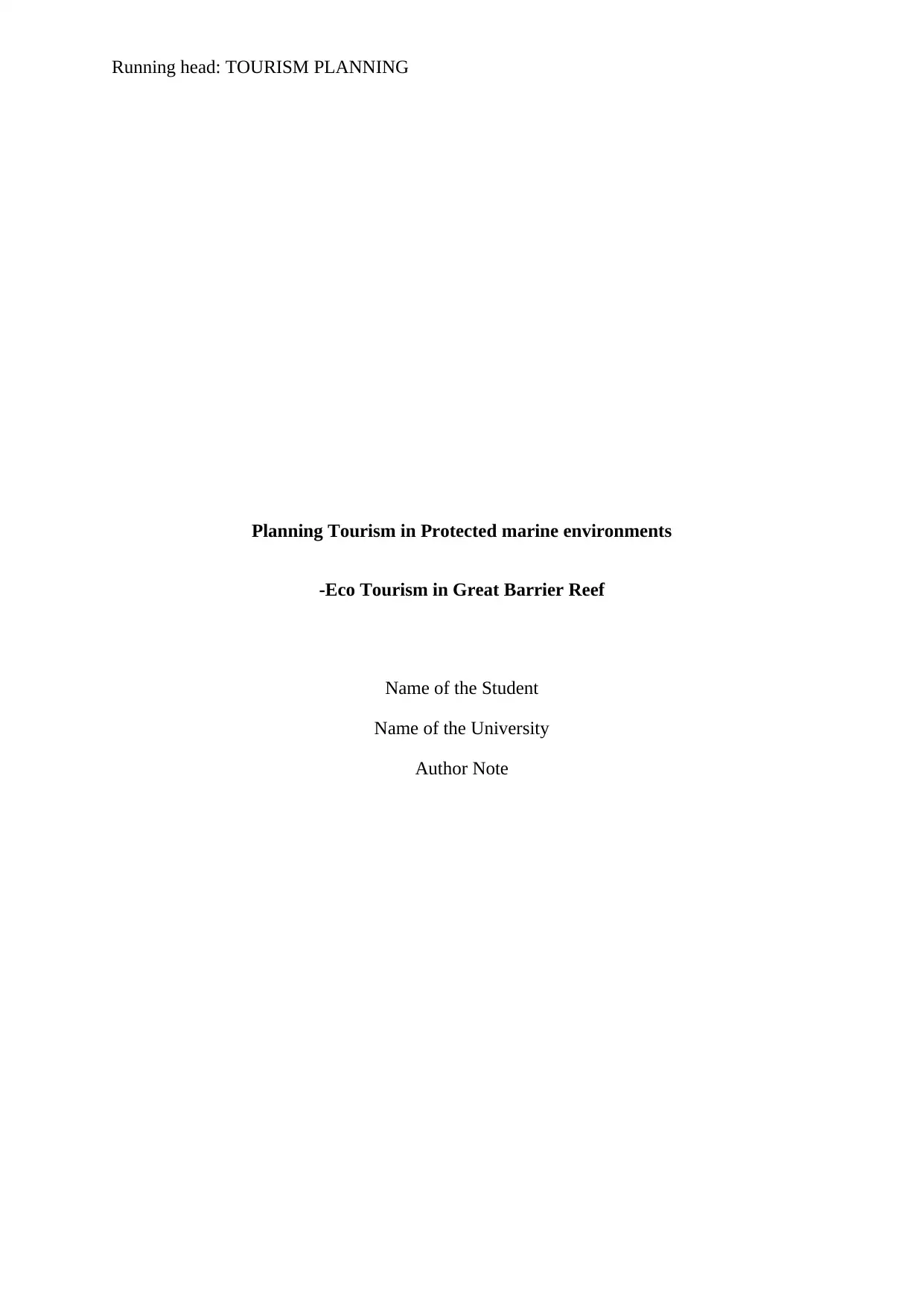
Running head: TOURISM PLANNING
Planning Tourism in Protected marine environments
-Eco Tourism in Great Barrier Reef
Name of the Student
Name of the University
Author Note
Planning Tourism in Protected marine environments
-Eco Tourism in Great Barrier Reef
Name of the Student
Name of the University
Author Note
Paraphrase This Document
Need a fresh take? Get an instant paraphrase of this document with our AI Paraphraser
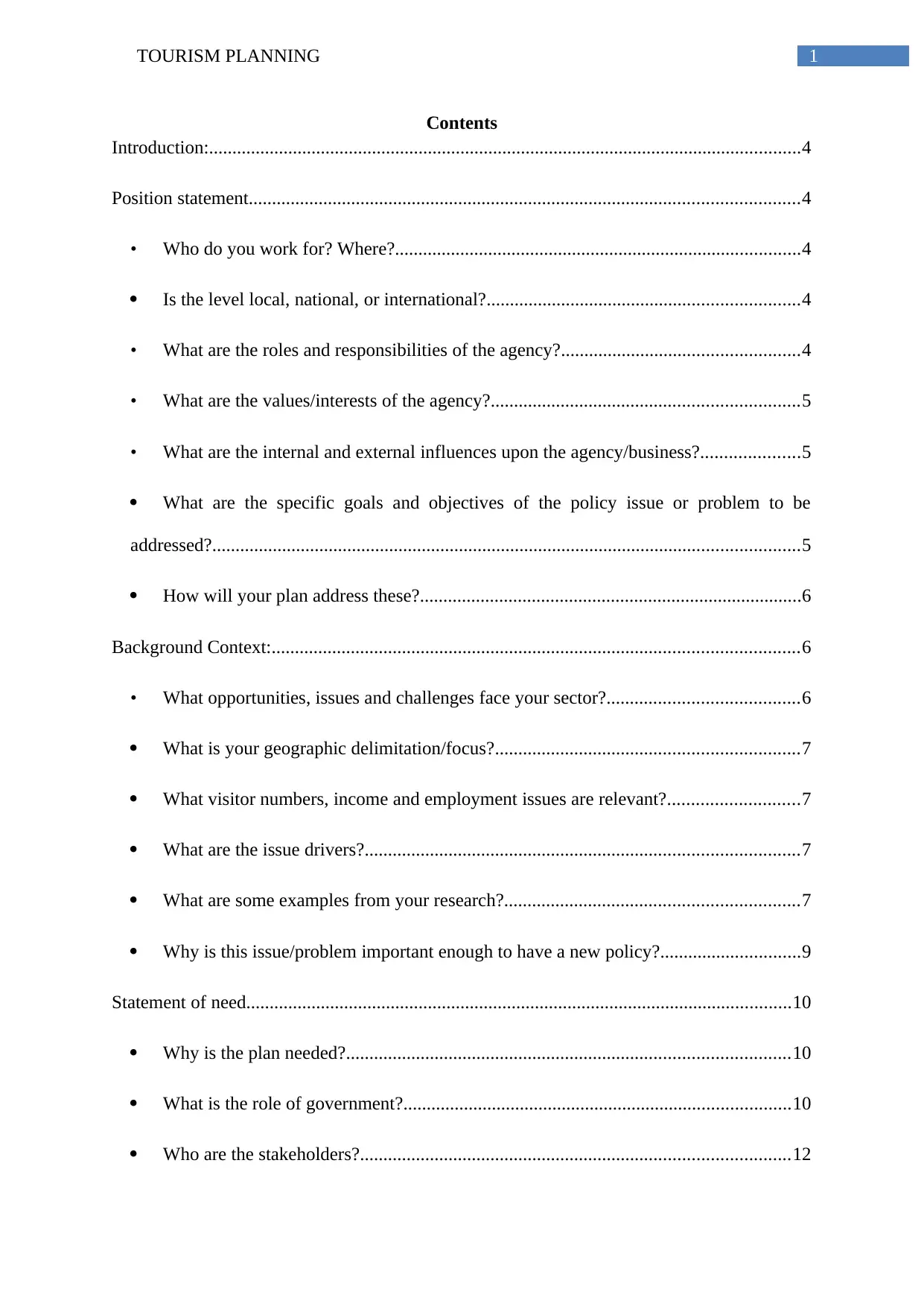
1TOURISM PLANNING
Contents
Introduction:...............................................................................................................................4
Position statement......................................................................................................................4
• Who do you work for? Where?.......................................................................................4
Is the level local, national, or international?...................................................................4
• What are the roles and responsibilities of the agency?...................................................4
• What are the values/interests of the agency?..................................................................5
• What are the internal and external influences upon the agency/business?.....................5
What are the specific goals and objectives of the policy issue or problem to be
addressed?..............................................................................................................................5
How will your plan address these?..................................................................................6
Background Context:.................................................................................................................6
• What opportunities, issues and challenges face your sector?.........................................6
What is your geographic delimitation/focus?.................................................................7
What visitor numbers, income and employment issues are relevant?............................7
What are the issue drivers?.............................................................................................7
What are some examples from your research?...............................................................7
Why is this issue/problem important enough to have a new policy?..............................9
Statement of need.....................................................................................................................10
Why is the plan needed?...............................................................................................10
What is the role of government?...................................................................................10
Who are the stakeholders?............................................................................................12
Contents
Introduction:...............................................................................................................................4
Position statement......................................................................................................................4
• Who do you work for? Where?.......................................................................................4
Is the level local, national, or international?...................................................................4
• What are the roles and responsibilities of the agency?...................................................4
• What are the values/interests of the agency?..................................................................5
• What are the internal and external influences upon the agency/business?.....................5
What are the specific goals and objectives of the policy issue or problem to be
addressed?..............................................................................................................................5
How will your plan address these?..................................................................................6
Background Context:.................................................................................................................6
• What opportunities, issues and challenges face your sector?.........................................6
What is your geographic delimitation/focus?.................................................................7
What visitor numbers, income and employment issues are relevant?............................7
What are the issue drivers?.............................................................................................7
What are some examples from your research?...............................................................7
Why is this issue/problem important enough to have a new policy?..............................9
Statement of need.....................................................................................................................10
Why is the plan needed?...............................................................................................10
What is the role of government?...................................................................................10
Who are the stakeholders?............................................................................................12
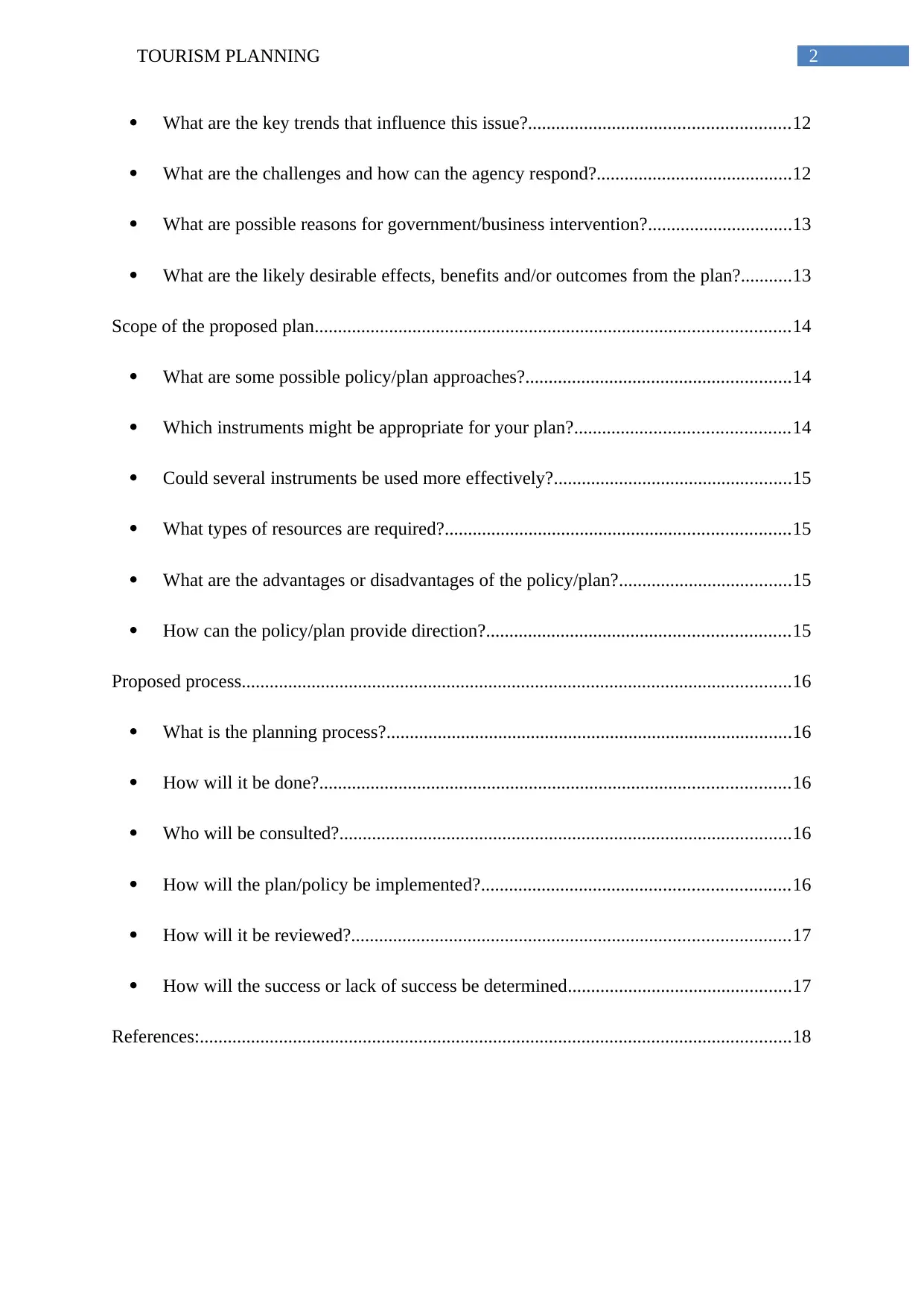
2TOURISM PLANNING
What are the key trends that influence this issue?........................................................12
What are the challenges and how can the agency respond?..........................................12
What are possible reasons for government/business intervention?...............................13
What are the likely desirable effects, benefits and/or outcomes from the plan?...........13
Scope of the proposed plan......................................................................................................14
What are some possible policy/plan approaches?.........................................................14
Which instruments might be appropriate for your plan?..............................................14
Could several instruments be used more effectively?...................................................15
What types of resources are required?..........................................................................15
What are the advantages or disadvantages of the policy/plan?.....................................15
How can the policy/plan provide direction?.................................................................15
Proposed process......................................................................................................................16
What is the planning process?.......................................................................................16
How will it be done?.....................................................................................................16
Who will be consulted?.................................................................................................16
How will the plan/policy be implemented?..................................................................16
How will it be reviewed?..............................................................................................17
How will the success or lack of success be determined................................................17
References:...............................................................................................................................18
What are the key trends that influence this issue?........................................................12
What are the challenges and how can the agency respond?..........................................12
What are possible reasons for government/business intervention?...............................13
What are the likely desirable effects, benefits and/or outcomes from the plan?...........13
Scope of the proposed plan......................................................................................................14
What are some possible policy/plan approaches?.........................................................14
Which instruments might be appropriate for your plan?..............................................14
Could several instruments be used more effectively?...................................................15
What types of resources are required?..........................................................................15
What are the advantages or disadvantages of the policy/plan?.....................................15
How can the policy/plan provide direction?.................................................................15
Proposed process......................................................................................................................16
What is the planning process?.......................................................................................16
How will it be done?.....................................................................................................16
Who will be consulted?.................................................................................................16
How will the plan/policy be implemented?..................................................................16
How will it be reviewed?..............................................................................................17
How will the success or lack of success be determined................................................17
References:...............................................................................................................................18
⊘ This is a preview!⊘
Do you want full access?
Subscribe today to unlock all pages.

Trusted by 1+ million students worldwide
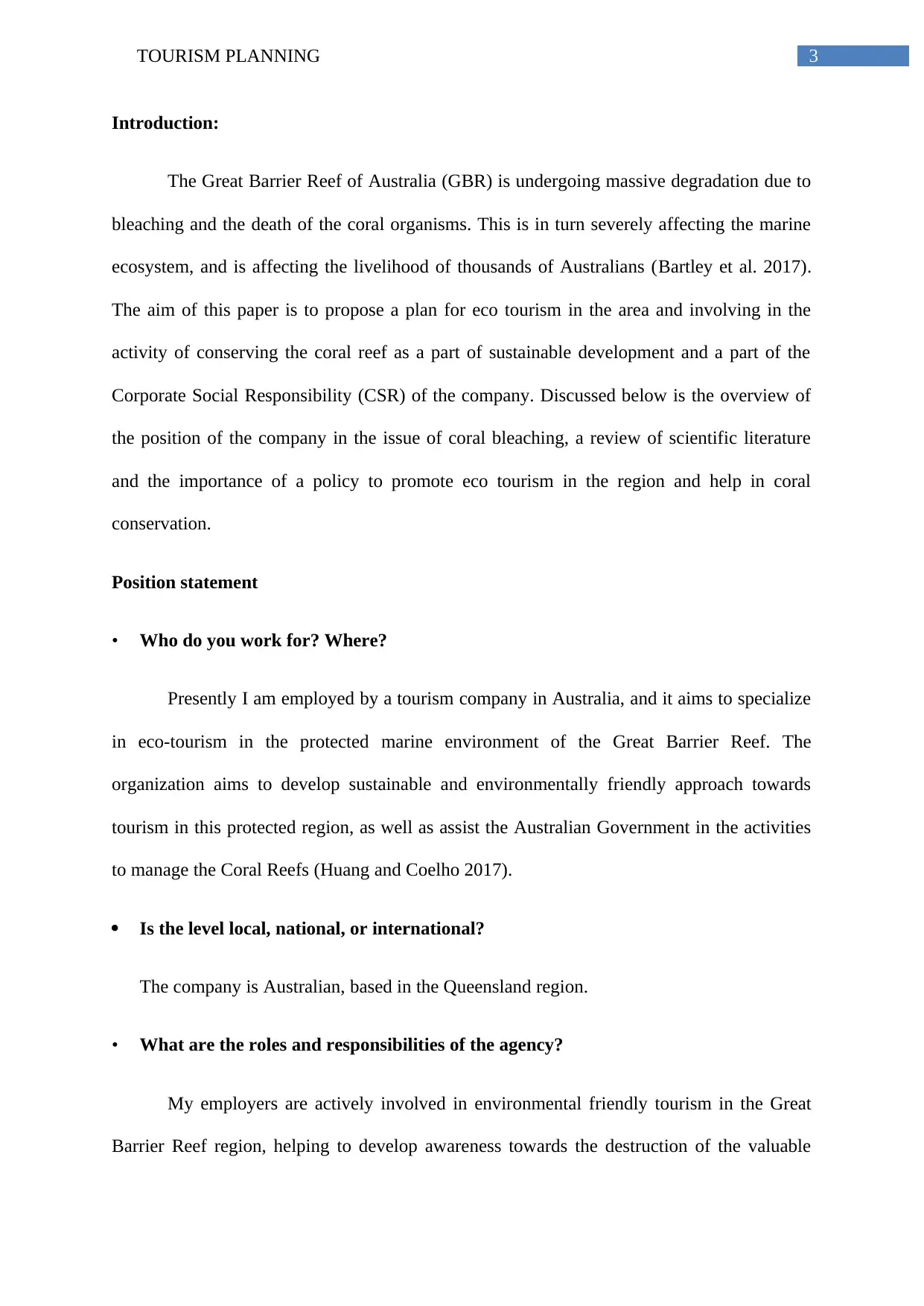
3TOURISM PLANNING
Introduction:
The Great Barrier Reef of Australia (GBR) is undergoing massive degradation due to
bleaching and the death of the coral organisms. This is in turn severely affecting the marine
ecosystem, and is affecting the livelihood of thousands of Australians (Bartley et al. 2017).
The aim of this paper is to propose a plan for eco tourism in the area and involving in the
activity of conserving the coral reef as a part of sustainable development and a part of the
Corporate Social Responsibility (CSR) of the company. Discussed below is the overview of
the position of the company in the issue of coral bleaching, a review of scientific literature
and the importance of a policy to promote eco tourism in the region and help in coral
conservation.
Position statement
• Who do you work for? Where?
Presently I am employed by a tourism company in Australia, and it aims to specialize
in eco-tourism in the protected marine environment of the Great Barrier Reef. The
organization aims to develop sustainable and environmentally friendly approach towards
tourism in this protected region, as well as assist the Australian Government in the activities
to manage the Coral Reefs (Huang and Coelho 2017).
Is the level local, national, or international?
The company is Australian, based in the Queensland region.
• What are the roles and responsibilities of the agency?
My employers are actively involved in environmental friendly tourism in the Great
Barrier Reef region, helping to develop awareness towards the destruction of the valuable
Introduction:
The Great Barrier Reef of Australia (GBR) is undergoing massive degradation due to
bleaching and the death of the coral organisms. This is in turn severely affecting the marine
ecosystem, and is affecting the livelihood of thousands of Australians (Bartley et al. 2017).
The aim of this paper is to propose a plan for eco tourism in the area and involving in the
activity of conserving the coral reef as a part of sustainable development and a part of the
Corporate Social Responsibility (CSR) of the company. Discussed below is the overview of
the position of the company in the issue of coral bleaching, a review of scientific literature
and the importance of a policy to promote eco tourism in the region and help in coral
conservation.
Position statement
• Who do you work for? Where?
Presently I am employed by a tourism company in Australia, and it aims to specialize
in eco-tourism in the protected marine environment of the Great Barrier Reef. The
organization aims to develop sustainable and environmentally friendly approach towards
tourism in this protected region, as well as assist the Australian Government in the activities
to manage the Coral Reefs (Huang and Coelho 2017).
Is the level local, national, or international?
The company is Australian, based in the Queensland region.
• What are the roles and responsibilities of the agency?
My employers are actively involved in environmental friendly tourism in the Great
Barrier Reef region, helping to develop awareness towards the destruction of the valuable
Paraphrase This Document
Need a fresh take? Get an instant paraphrase of this document with our AI Paraphraser
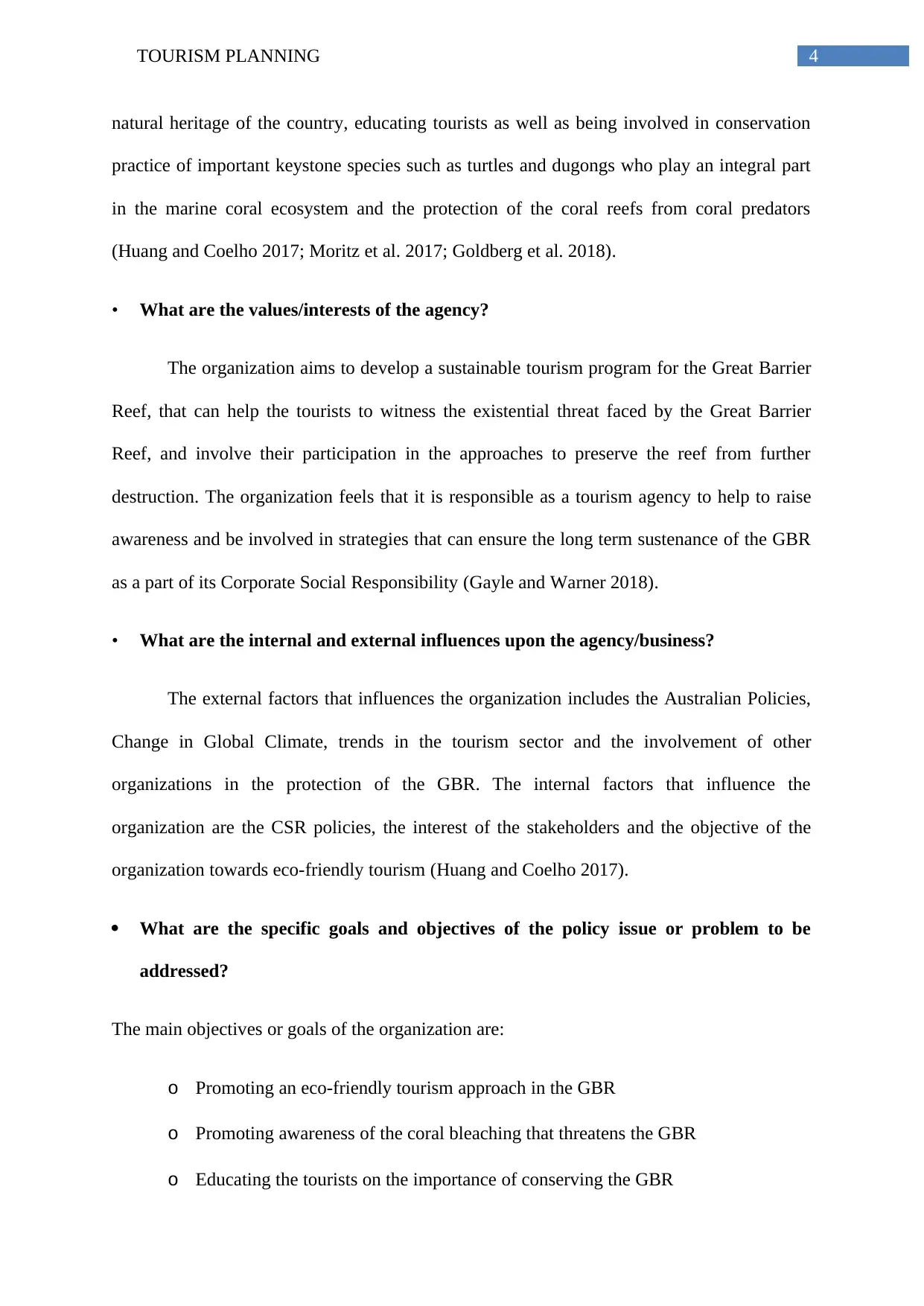
4TOURISM PLANNING
natural heritage of the country, educating tourists as well as being involved in conservation
practice of important keystone species such as turtles and dugongs who play an integral part
in the marine coral ecosystem and the protection of the coral reefs from coral predators
(Huang and Coelho 2017; Moritz et al. 2017; Goldberg et al. 2018).
• What are the values/interests of the agency?
The organization aims to develop a sustainable tourism program for the Great Barrier
Reef, that can help the tourists to witness the existential threat faced by the Great Barrier
Reef, and involve their participation in the approaches to preserve the reef from further
destruction. The organization feels that it is responsible as a tourism agency to help to raise
awareness and be involved in strategies that can ensure the long term sustenance of the GBR
as a part of its Corporate Social Responsibility (Gayle and Warner 2018).
• What are the internal and external influences upon the agency/business?
The external factors that influences the organization includes the Australian Policies,
Change in Global Climate, trends in the tourism sector and the involvement of other
organizations in the protection of the GBR. The internal factors that influence the
organization are the CSR policies, the interest of the stakeholders and the objective of the
organization towards eco-friendly tourism (Huang and Coelho 2017).
What are the specific goals and objectives of the policy issue or problem to be
addressed?
The main objectives or goals of the organization are:
o Promoting an eco-friendly tourism approach in the GBR
o Promoting awareness of the coral bleaching that threatens the GBR
o Educating the tourists on the importance of conserving the GBR
natural heritage of the country, educating tourists as well as being involved in conservation
practice of important keystone species such as turtles and dugongs who play an integral part
in the marine coral ecosystem and the protection of the coral reefs from coral predators
(Huang and Coelho 2017; Moritz et al. 2017; Goldberg et al. 2018).
• What are the values/interests of the agency?
The organization aims to develop a sustainable tourism program for the Great Barrier
Reef, that can help the tourists to witness the existential threat faced by the Great Barrier
Reef, and involve their participation in the approaches to preserve the reef from further
destruction. The organization feels that it is responsible as a tourism agency to help to raise
awareness and be involved in strategies that can ensure the long term sustenance of the GBR
as a part of its Corporate Social Responsibility (Gayle and Warner 2018).
• What are the internal and external influences upon the agency/business?
The external factors that influences the organization includes the Australian Policies,
Change in Global Climate, trends in the tourism sector and the involvement of other
organizations in the protection of the GBR. The internal factors that influence the
organization are the CSR policies, the interest of the stakeholders and the objective of the
organization towards eco-friendly tourism (Huang and Coelho 2017).
What are the specific goals and objectives of the policy issue or problem to be
addressed?
The main objectives or goals of the organization are:
o Promoting an eco-friendly tourism approach in the GBR
o Promoting awareness of the coral bleaching that threatens the GBR
o Educating the tourists on the importance of conserving the GBR
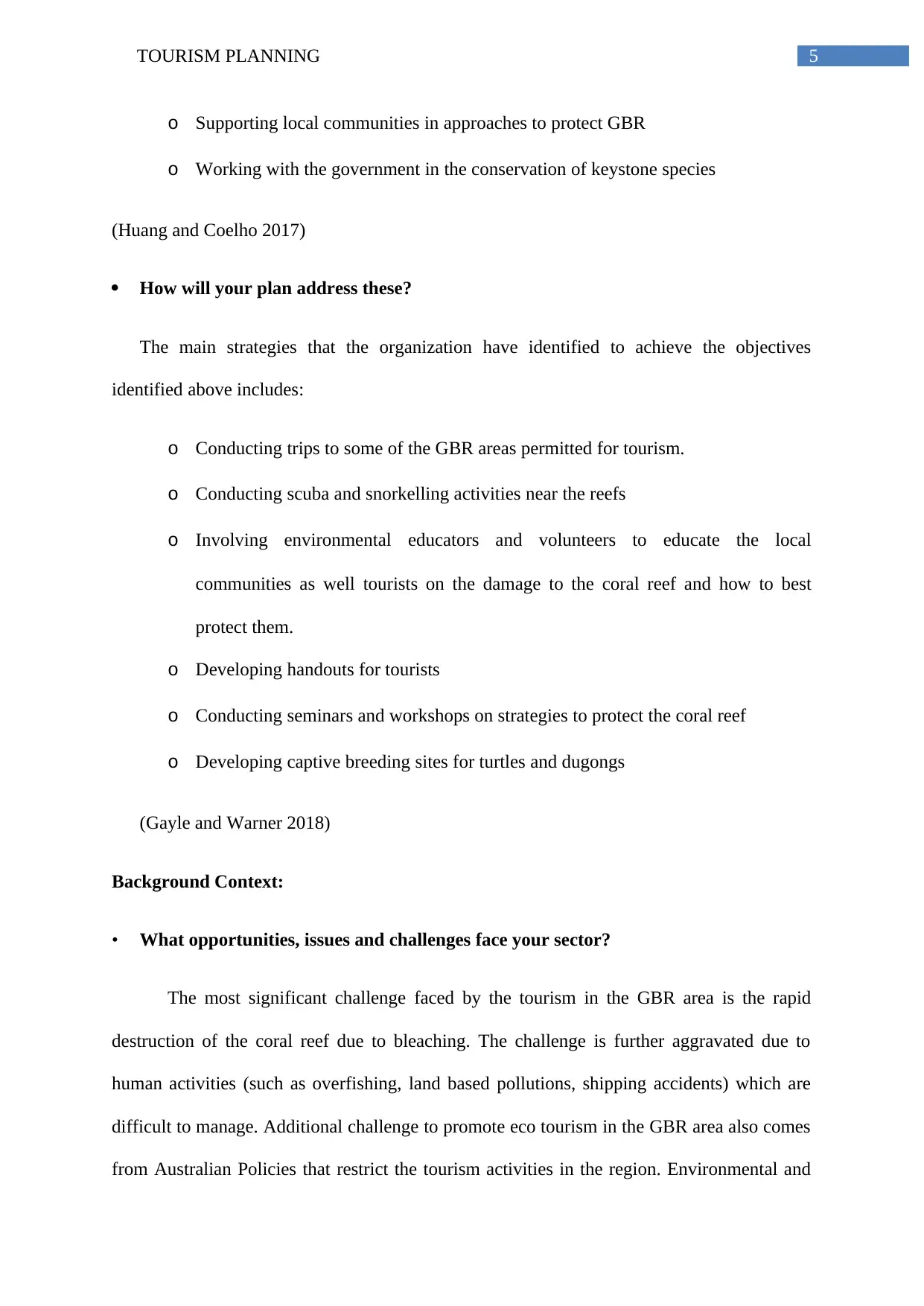
5TOURISM PLANNING
o Supporting local communities in approaches to protect GBR
o Working with the government in the conservation of keystone species
(Huang and Coelho 2017)
How will your plan address these?
The main strategies that the organization have identified to achieve the objectives
identified above includes:
o Conducting trips to some of the GBR areas permitted for tourism.
o Conducting scuba and snorkelling activities near the reefs
o Involving environmental educators and volunteers to educate the local
communities as well tourists on the damage to the coral reef and how to best
protect them.
o Developing handouts for tourists
o Conducting seminars and workshops on strategies to protect the coral reef
o Developing captive breeding sites for turtles and dugongs
(Gayle and Warner 2018)
Background Context:
• What opportunities, issues and challenges face your sector?
The most significant challenge faced by the tourism in the GBR area is the rapid
destruction of the coral reef due to bleaching. The challenge is further aggravated due to
human activities (such as overfishing, land based pollutions, shipping accidents) which are
difficult to manage. Additional challenge to promote eco tourism in the GBR area also comes
from Australian Policies that restrict the tourism activities in the region. Environmental and
o Supporting local communities in approaches to protect GBR
o Working with the government in the conservation of keystone species
(Huang and Coelho 2017)
How will your plan address these?
The main strategies that the organization have identified to achieve the objectives
identified above includes:
o Conducting trips to some of the GBR areas permitted for tourism.
o Conducting scuba and snorkelling activities near the reefs
o Involving environmental educators and volunteers to educate the local
communities as well tourists on the damage to the coral reef and how to best
protect them.
o Developing handouts for tourists
o Conducting seminars and workshops on strategies to protect the coral reef
o Developing captive breeding sites for turtles and dugongs
(Gayle and Warner 2018)
Background Context:
• What opportunities, issues and challenges face your sector?
The most significant challenge faced by the tourism in the GBR area is the rapid
destruction of the coral reef due to bleaching. The challenge is further aggravated due to
human activities (such as overfishing, land based pollutions, shipping accidents) which are
difficult to manage. Additional challenge to promote eco tourism in the GBR area also comes
from Australian Policies that restrict the tourism activities in the region. Environmental and
⊘ This is a preview!⊘
Do you want full access?
Subscribe today to unlock all pages.

Trusted by 1+ million students worldwide
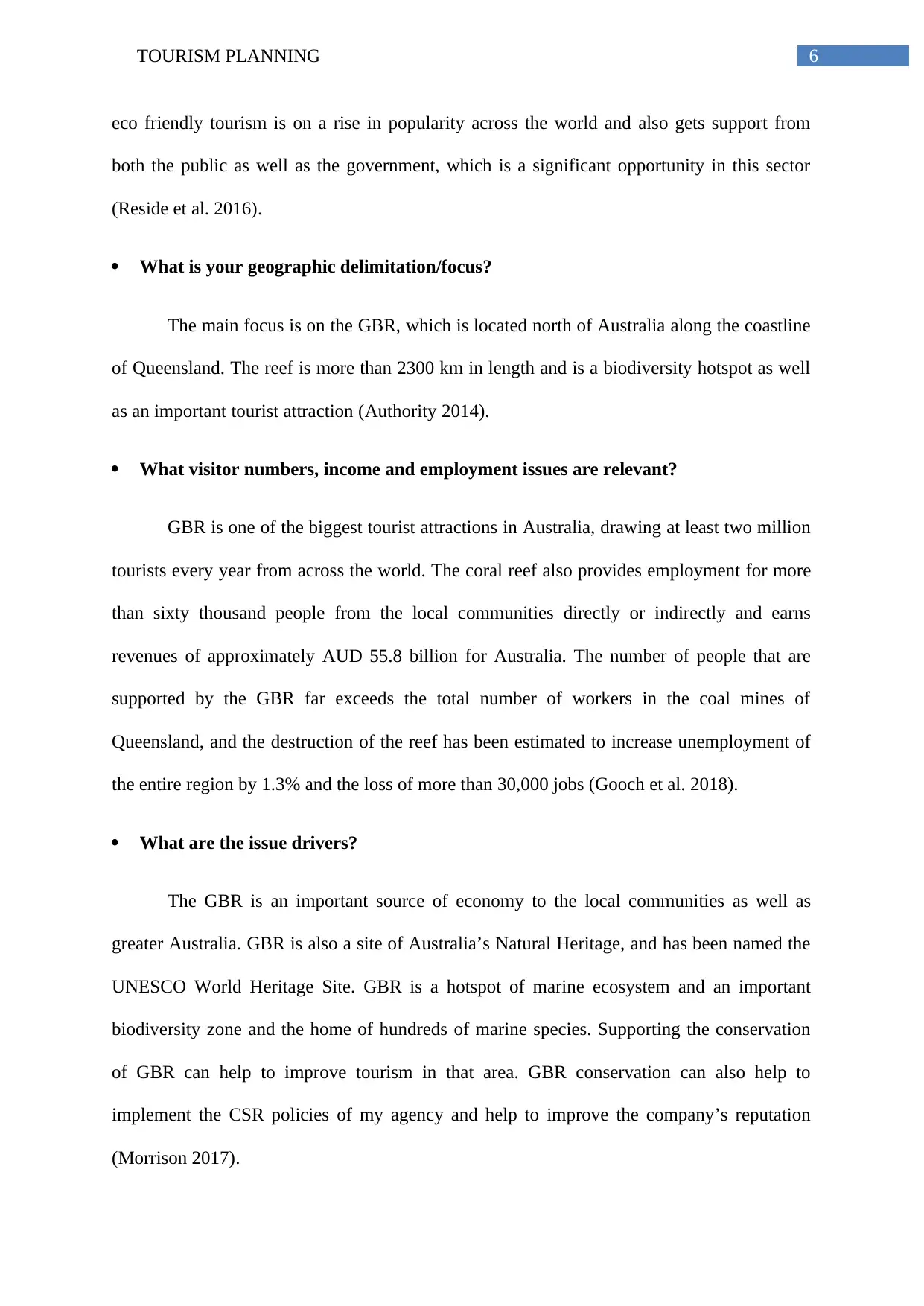
6TOURISM PLANNING
eco friendly tourism is on a rise in popularity across the world and also gets support from
both the public as well as the government, which is a significant opportunity in this sector
(Reside et al. 2016).
What is your geographic delimitation/focus?
The main focus is on the GBR, which is located north of Australia along the coastline
of Queensland. The reef is more than 2300 km in length and is a biodiversity hotspot as well
as an important tourist attraction (Authority 2014).
What visitor numbers, income and employment issues are relevant?
GBR is one of the biggest tourist attractions in Australia, drawing at least two million
tourists every year from across the world. The coral reef also provides employment for more
than sixty thousand people from the local communities directly or indirectly and earns
revenues of approximately AUD 55.8 billion for Australia. The number of people that are
supported by the GBR far exceeds the total number of workers in the coal mines of
Queensland, and the destruction of the reef has been estimated to increase unemployment of
the entire region by 1.3% and the loss of more than 30,000 jobs (Gooch et al. 2018).
What are the issue drivers?
The GBR is an important source of economy to the local communities as well as
greater Australia. GBR is also a site of Australia’s Natural Heritage, and has been named the
UNESCO World Heritage Site. GBR is a hotspot of marine ecosystem and an important
biodiversity zone and the home of hundreds of marine species. Supporting the conservation
of GBR can help to improve tourism in that area. GBR conservation can also help to
implement the CSR policies of my agency and help to improve the company’s reputation
(Morrison 2017).
eco friendly tourism is on a rise in popularity across the world and also gets support from
both the public as well as the government, which is a significant opportunity in this sector
(Reside et al. 2016).
What is your geographic delimitation/focus?
The main focus is on the GBR, which is located north of Australia along the coastline
of Queensland. The reef is more than 2300 km in length and is a biodiversity hotspot as well
as an important tourist attraction (Authority 2014).
What visitor numbers, income and employment issues are relevant?
GBR is one of the biggest tourist attractions in Australia, drawing at least two million
tourists every year from across the world. The coral reef also provides employment for more
than sixty thousand people from the local communities directly or indirectly and earns
revenues of approximately AUD 55.8 billion for Australia. The number of people that are
supported by the GBR far exceeds the total number of workers in the coal mines of
Queensland, and the destruction of the reef has been estimated to increase unemployment of
the entire region by 1.3% and the loss of more than 30,000 jobs (Gooch et al. 2018).
What are the issue drivers?
The GBR is an important source of economy to the local communities as well as
greater Australia. GBR is also a site of Australia’s Natural Heritage, and has been named the
UNESCO World Heritage Site. GBR is a hotspot of marine ecosystem and an important
biodiversity zone and the home of hundreds of marine species. Supporting the conservation
of GBR can help to improve tourism in that area. GBR conservation can also help to
implement the CSR policies of my agency and help to improve the company’s reputation
(Morrison 2017).
Paraphrase This Document
Need a fresh take? Get an instant paraphrase of this document with our AI Paraphraser
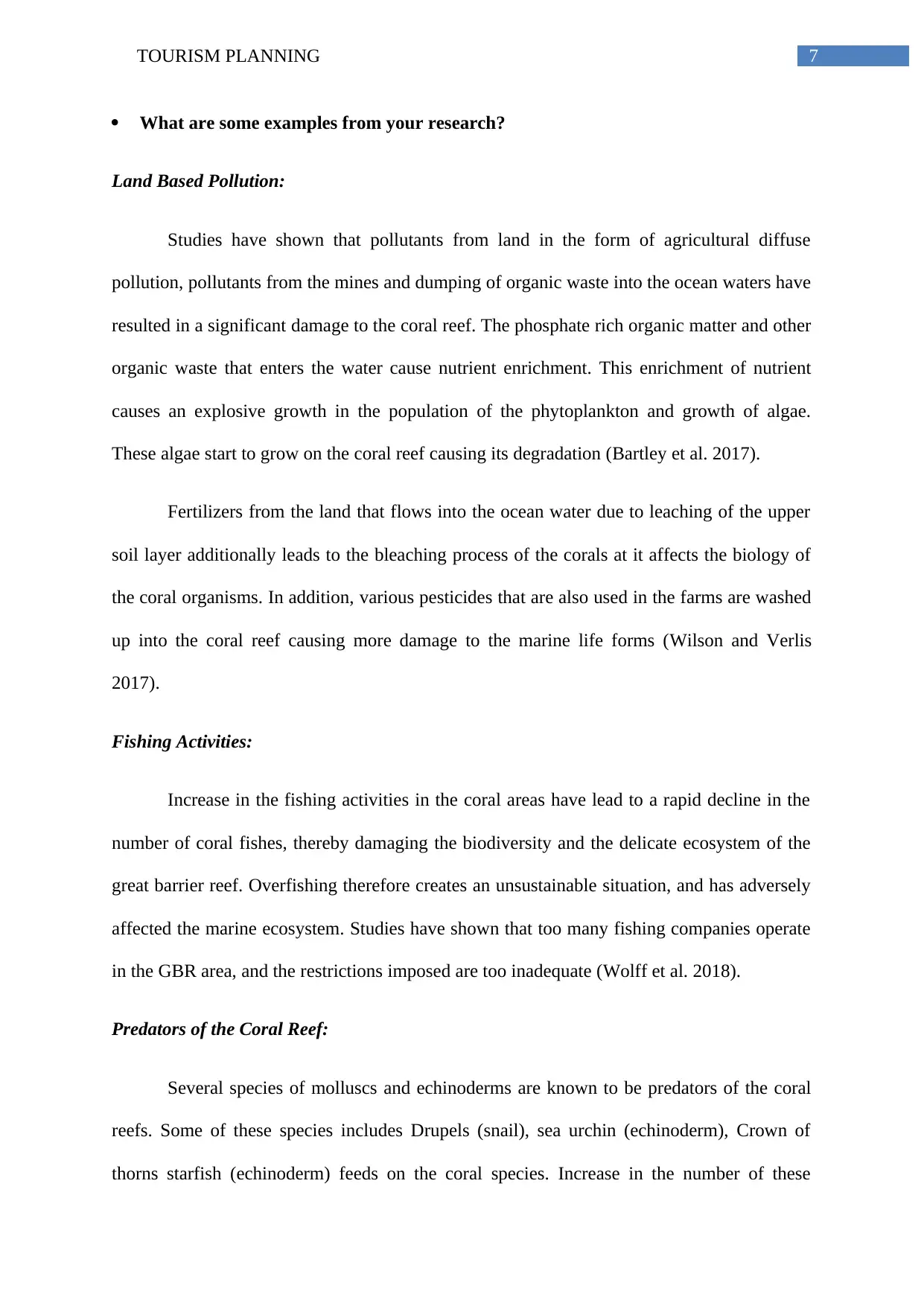
7TOURISM PLANNING
What are some examples from your research?
Land Based Pollution:
Studies have shown that pollutants from land in the form of agricultural diffuse
pollution, pollutants from the mines and dumping of organic waste into the ocean waters have
resulted in a significant damage to the coral reef. The phosphate rich organic matter and other
organic waste that enters the water cause nutrient enrichment. This enrichment of nutrient
causes an explosive growth in the population of the phytoplankton and growth of algae.
These algae start to grow on the coral reef causing its degradation (Bartley et al. 2017).
Fertilizers from the land that flows into the ocean water due to leaching of the upper
soil layer additionally leads to the bleaching process of the corals at it affects the biology of
the coral organisms. In addition, various pesticides that are also used in the farms are washed
up into the coral reef causing more damage to the marine life forms (Wilson and Verlis
2017).
Fishing Activities:
Increase in the fishing activities in the coral areas have lead to a rapid decline in the
number of coral fishes, thereby damaging the biodiversity and the delicate ecosystem of the
great barrier reef. Overfishing therefore creates an unsustainable situation, and has adversely
affected the marine ecosystem. Studies have shown that too many fishing companies operate
in the GBR area, and the restrictions imposed are too inadequate (Wolff et al. 2018).
Predators of the Coral Reef:
Several species of molluscs and echinoderms are known to be predators of the coral
reefs. Some of these species includes Drupels (snail), sea urchin (echinoderm), Crown of
thorns starfish (echinoderm) feeds on the coral species. Increase in the number of these
What are some examples from your research?
Land Based Pollution:
Studies have shown that pollutants from land in the form of agricultural diffuse
pollution, pollutants from the mines and dumping of organic waste into the ocean waters have
resulted in a significant damage to the coral reef. The phosphate rich organic matter and other
organic waste that enters the water cause nutrient enrichment. This enrichment of nutrient
causes an explosive growth in the population of the phytoplankton and growth of algae.
These algae start to grow on the coral reef causing its degradation (Bartley et al. 2017).
Fertilizers from the land that flows into the ocean water due to leaching of the upper
soil layer additionally leads to the bleaching process of the corals at it affects the biology of
the coral organisms. In addition, various pesticides that are also used in the farms are washed
up into the coral reef causing more damage to the marine life forms (Wilson and Verlis
2017).
Fishing Activities:
Increase in the fishing activities in the coral areas have lead to a rapid decline in the
number of coral fishes, thereby damaging the biodiversity and the delicate ecosystem of the
great barrier reef. Overfishing therefore creates an unsustainable situation, and has adversely
affected the marine ecosystem. Studies have shown that too many fishing companies operate
in the GBR area, and the restrictions imposed are too inadequate (Wolff et al. 2018).
Predators of the Coral Reef:
Several species of molluscs and echinoderms are known to be predators of the coral
reefs. Some of these species includes Drupels (snail), sea urchin (echinoderm), Crown of
thorns starfish (echinoderm) feeds on the coral species. Increase in the number of these
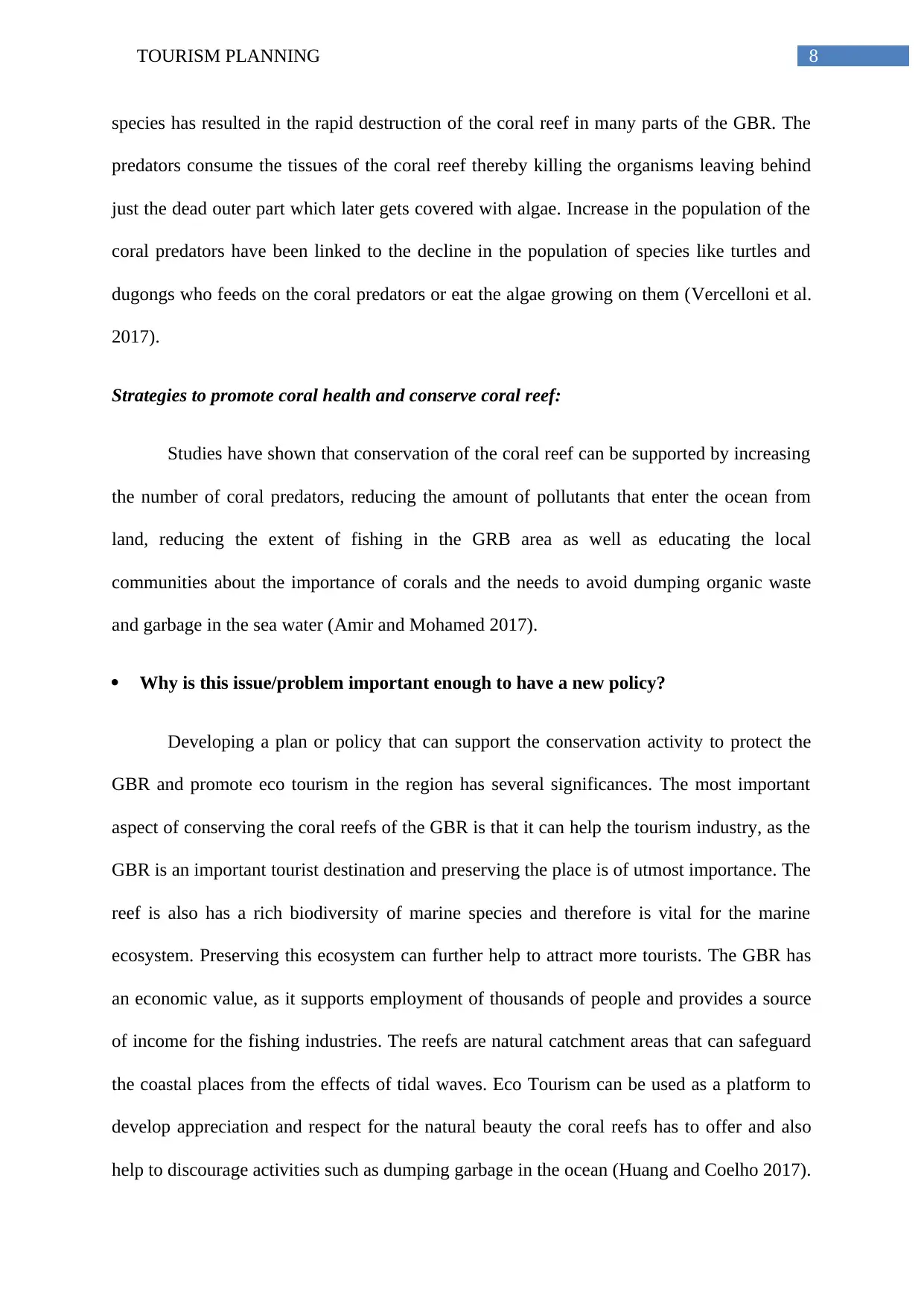
8TOURISM PLANNING
species has resulted in the rapid destruction of the coral reef in many parts of the GBR. The
predators consume the tissues of the coral reef thereby killing the organisms leaving behind
just the dead outer part which later gets covered with algae. Increase in the population of the
coral predators have been linked to the decline in the population of species like turtles and
dugongs who feeds on the coral predators or eat the algae growing on them (Vercelloni et al.
2017).
Strategies to promote coral health and conserve coral reef:
Studies have shown that conservation of the coral reef can be supported by increasing
the number of coral predators, reducing the amount of pollutants that enter the ocean from
land, reducing the extent of fishing in the GRB area as well as educating the local
communities about the importance of corals and the needs to avoid dumping organic waste
and garbage in the sea water (Amir and Mohamed 2017).
Why is this issue/problem important enough to have a new policy?
Developing a plan or policy that can support the conservation activity to protect the
GBR and promote eco tourism in the region has several significances. The most important
aspect of conserving the coral reefs of the GBR is that it can help the tourism industry, as the
GBR is an important tourist destination and preserving the place is of utmost importance. The
reef is also has a rich biodiversity of marine species and therefore is vital for the marine
ecosystem. Preserving this ecosystem can further help to attract more tourists. The GBR has
an economic value, as it supports employment of thousands of people and provides a source
of income for the fishing industries. The reefs are natural catchment areas that can safeguard
the coastal places from the effects of tidal waves. Eco Tourism can be used as a platform to
develop appreciation and respect for the natural beauty the coral reefs has to offer and also
help to discourage activities such as dumping garbage in the ocean (Huang and Coelho 2017).
species has resulted in the rapid destruction of the coral reef in many parts of the GBR. The
predators consume the tissues of the coral reef thereby killing the organisms leaving behind
just the dead outer part which later gets covered with algae. Increase in the population of the
coral predators have been linked to the decline in the population of species like turtles and
dugongs who feeds on the coral predators or eat the algae growing on them (Vercelloni et al.
2017).
Strategies to promote coral health and conserve coral reef:
Studies have shown that conservation of the coral reef can be supported by increasing
the number of coral predators, reducing the amount of pollutants that enter the ocean from
land, reducing the extent of fishing in the GRB area as well as educating the local
communities about the importance of corals and the needs to avoid dumping organic waste
and garbage in the sea water (Amir and Mohamed 2017).
Why is this issue/problem important enough to have a new policy?
Developing a plan or policy that can support the conservation activity to protect the
GBR and promote eco tourism in the region has several significances. The most important
aspect of conserving the coral reefs of the GBR is that it can help the tourism industry, as the
GBR is an important tourist destination and preserving the place is of utmost importance. The
reef is also has a rich biodiversity of marine species and therefore is vital for the marine
ecosystem. Preserving this ecosystem can further help to attract more tourists. The GBR has
an economic value, as it supports employment of thousands of people and provides a source
of income for the fishing industries. The reefs are natural catchment areas that can safeguard
the coastal places from the effects of tidal waves. Eco Tourism can be used as a platform to
develop appreciation and respect for the natural beauty the coral reefs has to offer and also
help to discourage activities such as dumping garbage in the ocean (Huang and Coelho 2017).
⊘ This is a preview!⊘
Do you want full access?
Subscribe today to unlock all pages.

Trusted by 1+ million students worldwide
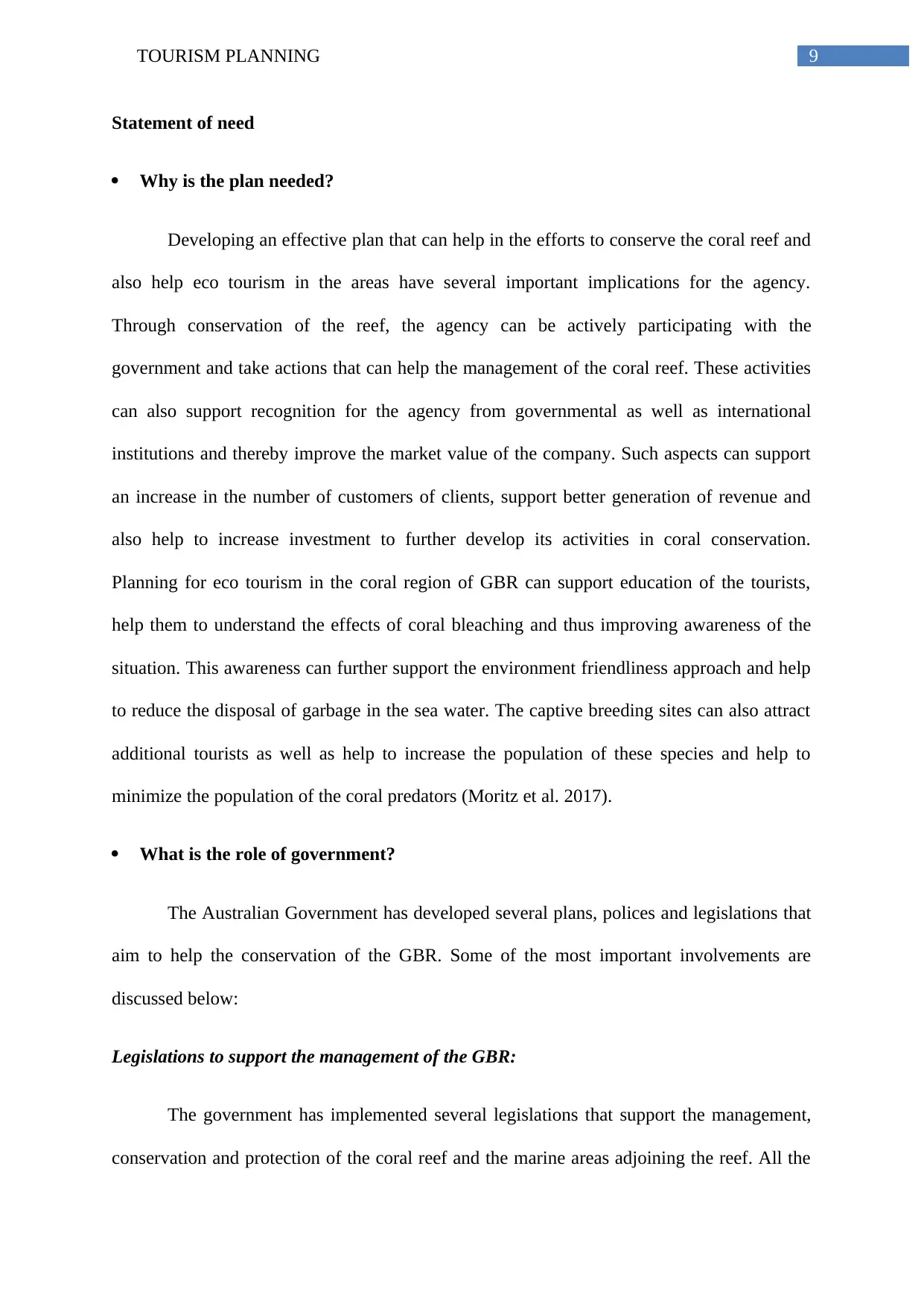
9TOURISM PLANNING
Statement of need
Why is the plan needed?
Developing an effective plan that can help in the efforts to conserve the coral reef and
also help eco tourism in the areas have several important implications for the agency.
Through conservation of the reef, the agency can be actively participating with the
government and take actions that can help the management of the coral reef. These activities
can also support recognition for the agency from governmental as well as international
institutions and thereby improve the market value of the company. Such aspects can support
an increase in the number of customers of clients, support better generation of revenue and
also help to increase investment to further develop its activities in coral conservation.
Planning for eco tourism in the coral region of GBR can support education of the tourists,
help them to understand the effects of coral bleaching and thus improving awareness of the
situation. This awareness can further support the environment friendliness approach and help
to reduce the disposal of garbage in the sea water. The captive breeding sites can also attract
additional tourists as well as help to increase the population of these species and help to
minimize the population of the coral predators (Moritz et al. 2017).
What is the role of government?
The Australian Government has developed several plans, polices and legislations that
aim to help the conservation of the GBR. Some of the most important involvements are
discussed below:
Legislations to support the management of the GBR:
The government has implemented several legislations that support the management,
conservation and protection of the coral reef and the marine areas adjoining the reef. All the
Statement of need
Why is the plan needed?
Developing an effective plan that can help in the efforts to conserve the coral reef and
also help eco tourism in the areas have several important implications for the agency.
Through conservation of the reef, the agency can be actively participating with the
government and take actions that can help the management of the coral reef. These activities
can also support recognition for the agency from governmental as well as international
institutions and thereby improve the market value of the company. Such aspects can support
an increase in the number of customers of clients, support better generation of revenue and
also help to increase investment to further develop its activities in coral conservation.
Planning for eco tourism in the coral region of GBR can support education of the tourists,
help them to understand the effects of coral bleaching and thus improving awareness of the
situation. This awareness can further support the environment friendliness approach and help
to reduce the disposal of garbage in the sea water. The captive breeding sites can also attract
additional tourists as well as help to increase the population of these species and help to
minimize the population of the coral predators (Moritz et al. 2017).
What is the role of government?
The Australian Government has developed several plans, polices and legislations that
aim to help the conservation of the GBR. Some of the most important involvements are
discussed below:
Legislations to support the management of the GBR:
The government has implemented several legislations that support the management,
conservation and protection of the coral reef and the marine areas adjoining the reef. All the
Paraphrase This Document
Need a fresh take? Get an instant paraphrase of this document with our AI Paraphraser
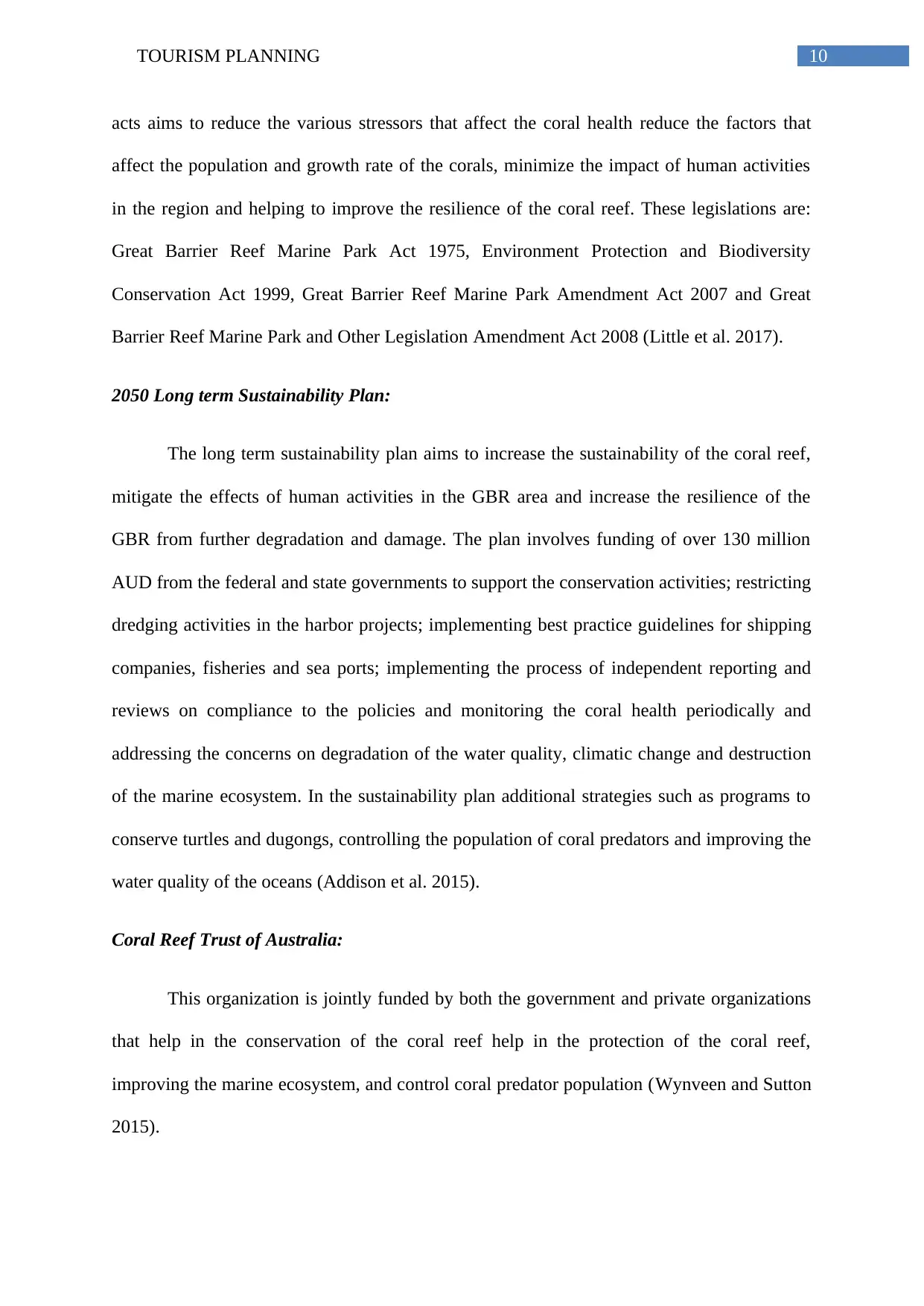
10TOURISM PLANNING
acts aims to reduce the various stressors that affect the coral health reduce the factors that
affect the population and growth rate of the corals, minimize the impact of human activities
in the region and helping to improve the resilience of the coral reef. These legislations are:
Great Barrier Reef Marine Park Act 1975, Environment Protection and Biodiversity
Conservation Act 1999, Great Barrier Reef Marine Park Amendment Act 2007 and Great
Barrier Reef Marine Park and Other Legislation Amendment Act 2008 (Little et al. 2017).
2050 Long term Sustainability Plan:
The long term sustainability plan aims to increase the sustainability of the coral reef,
mitigate the effects of human activities in the GBR area and increase the resilience of the
GBR from further degradation and damage. The plan involves funding of over 130 million
AUD from the federal and state governments to support the conservation activities; restricting
dredging activities in the harbor projects; implementing best practice guidelines for shipping
companies, fisheries and sea ports; implementing the process of independent reporting and
reviews on compliance to the policies and monitoring the coral health periodically and
addressing the concerns on degradation of the water quality, climatic change and destruction
of the marine ecosystem. In the sustainability plan additional strategies such as programs to
conserve turtles and dugongs, controlling the population of coral predators and improving the
water quality of the oceans (Addison et al. 2015).
Coral Reef Trust of Australia:
This organization is jointly funded by both the government and private organizations
that help in the conservation of the coral reef help in the protection of the coral reef,
improving the marine ecosystem, and control coral predator population (Wynveen and Sutton
2015).
acts aims to reduce the various stressors that affect the coral health reduce the factors that
affect the population and growth rate of the corals, minimize the impact of human activities
in the region and helping to improve the resilience of the coral reef. These legislations are:
Great Barrier Reef Marine Park Act 1975, Environment Protection and Biodiversity
Conservation Act 1999, Great Barrier Reef Marine Park Amendment Act 2007 and Great
Barrier Reef Marine Park and Other Legislation Amendment Act 2008 (Little et al. 2017).
2050 Long term Sustainability Plan:
The long term sustainability plan aims to increase the sustainability of the coral reef,
mitigate the effects of human activities in the GBR area and increase the resilience of the
GBR from further degradation and damage. The plan involves funding of over 130 million
AUD from the federal and state governments to support the conservation activities; restricting
dredging activities in the harbor projects; implementing best practice guidelines for shipping
companies, fisheries and sea ports; implementing the process of independent reporting and
reviews on compliance to the policies and monitoring the coral health periodically and
addressing the concerns on degradation of the water quality, climatic change and destruction
of the marine ecosystem. In the sustainability plan additional strategies such as programs to
conserve turtles and dugongs, controlling the population of coral predators and improving the
water quality of the oceans (Addison et al. 2015).
Coral Reef Trust of Australia:
This organization is jointly funded by both the government and private organizations
that help in the conservation of the coral reef help in the protection of the coral reef,
improving the marine ecosystem, and control coral predator population (Wynveen and Sutton
2015).
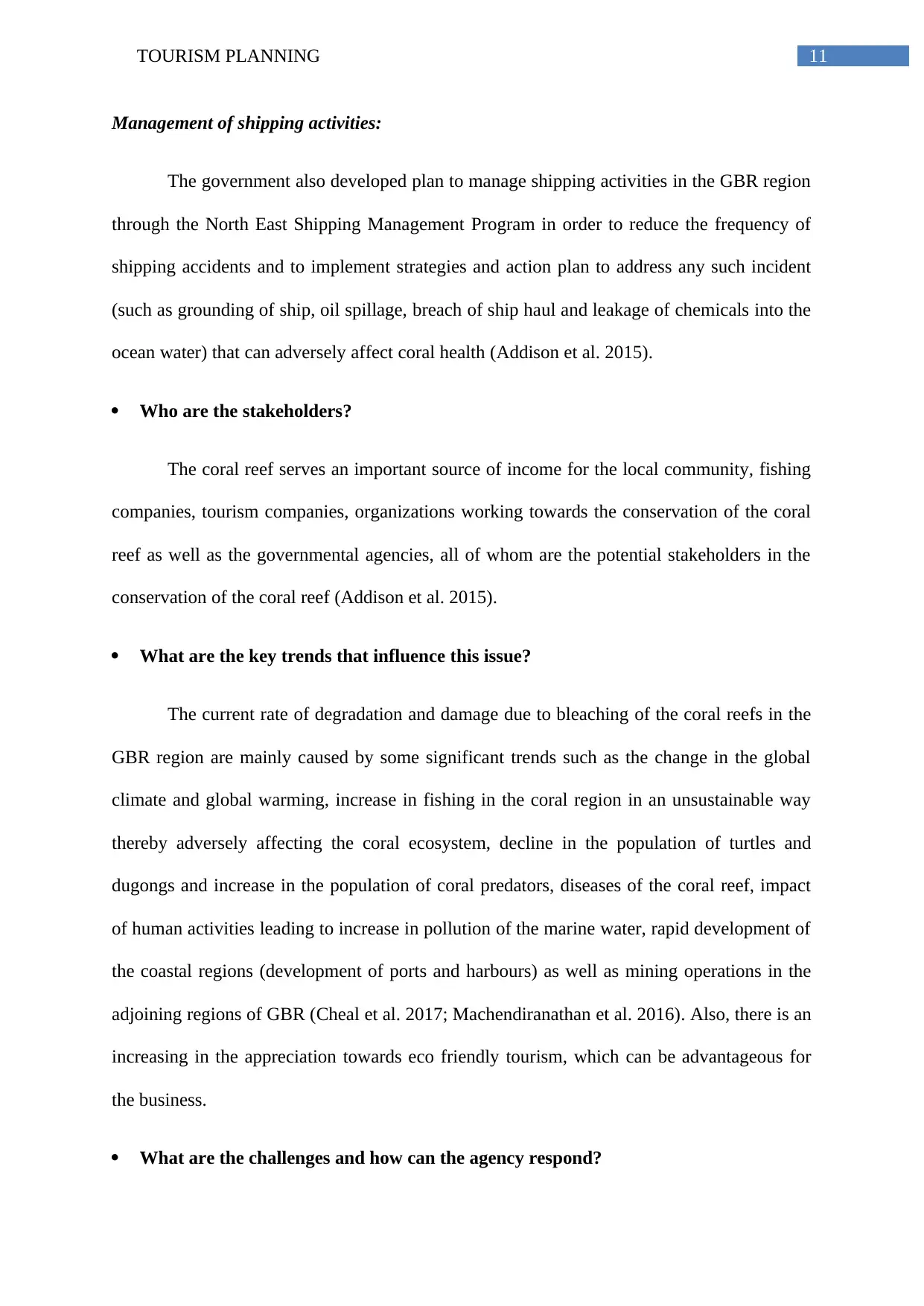
11TOURISM PLANNING
Management of shipping activities:
The government also developed plan to manage shipping activities in the GBR region
through the North East Shipping Management Program in order to reduce the frequency of
shipping accidents and to implement strategies and action plan to address any such incident
(such as grounding of ship, oil spillage, breach of ship haul and leakage of chemicals into the
ocean water) that can adversely affect coral health (Addison et al. 2015).
Who are the stakeholders?
The coral reef serves an important source of income for the local community, fishing
companies, tourism companies, organizations working towards the conservation of the coral
reef as well as the governmental agencies, all of whom are the potential stakeholders in the
conservation of the coral reef (Addison et al. 2015).
What are the key trends that influence this issue?
The current rate of degradation and damage due to bleaching of the coral reefs in the
GBR region are mainly caused by some significant trends such as the change in the global
climate and global warming, increase in fishing in the coral region in an unsustainable way
thereby adversely affecting the coral ecosystem, decline in the population of turtles and
dugongs and increase in the population of coral predators, diseases of the coral reef, impact
of human activities leading to increase in pollution of the marine water, rapid development of
the coastal regions (development of ports and harbours) as well as mining operations in the
adjoining regions of GBR (Cheal et al. 2017; Machendiranathan et al. 2016). Also, there is an
increasing in the appreciation towards eco friendly tourism, which can be advantageous for
the business.
What are the challenges and how can the agency respond?
Management of shipping activities:
The government also developed plan to manage shipping activities in the GBR region
through the North East Shipping Management Program in order to reduce the frequency of
shipping accidents and to implement strategies and action plan to address any such incident
(such as grounding of ship, oil spillage, breach of ship haul and leakage of chemicals into the
ocean water) that can adversely affect coral health (Addison et al. 2015).
Who are the stakeholders?
The coral reef serves an important source of income for the local community, fishing
companies, tourism companies, organizations working towards the conservation of the coral
reef as well as the governmental agencies, all of whom are the potential stakeholders in the
conservation of the coral reef (Addison et al. 2015).
What are the key trends that influence this issue?
The current rate of degradation and damage due to bleaching of the coral reefs in the
GBR region are mainly caused by some significant trends such as the change in the global
climate and global warming, increase in fishing in the coral region in an unsustainable way
thereby adversely affecting the coral ecosystem, decline in the population of turtles and
dugongs and increase in the population of coral predators, diseases of the coral reef, impact
of human activities leading to increase in pollution of the marine water, rapid development of
the coastal regions (development of ports and harbours) as well as mining operations in the
adjoining regions of GBR (Cheal et al. 2017; Machendiranathan et al. 2016). Also, there is an
increasing in the appreciation towards eco friendly tourism, which can be advantageous for
the business.
What are the challenges and how can the agency respond?
⊘ This is a preview!⊘
Do you want full access?
Subscribe today to unlock all pages.

Trusted by 1+ million students worldwide
1 out of 21
Related Documents
Your All-in-One AI-Powered Toolkit for Academic Success.
+13062052269
info@desklib.com
Available 24*7 on WhatsApp / Email
![[object Object]](/_next/static/media/star-bottom.7253800d.svg)
Unlock your academic potential
Copyright © 2020–2025 A2Z Services. All Rights Reserved. Developed and managed by ZUCOL.





